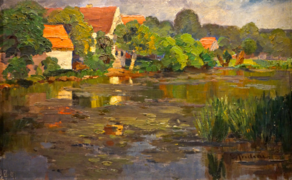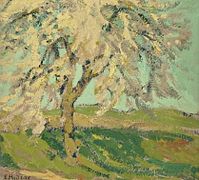Elisabeth Andrae
Elisabeth Andrae (born August 3, 1876 in Leipzig , † 1945 in Dresden ; full name: Louise Elisabeth Andrae ) was a German painter.
Her brother was Walter Andrae , who later became director of the Vorderasiatisches Museum in Berlin . After studying with Adolf Thamm in Dresden and Hans Richard von Volkmann in Karlsruhe , she lived in Dresden. Elisabeth Andrae belonged with Clara Arnheim , Elisabeth Büchsel and other artists to the circle of the Hiddensoer Künstlerinnenbund , also called disparagingly Hiddenseer Malweiber , who regularly exhibited in the Blue Barn in Vitte. In 1906 she was with the painting “Sunspots” at the Great Berlin Art Exhibitionrepresented. In 1909 she exhibited together with the painters based in Ahrenshoop in the newly founded Kunstkaten , as well as in Dresden and Berlin. The Dresden City Collections acquired their painting “Neustädter Markt”.
Stylistically, she is one of the painters of German Art Nouveau and Symbolism . Elisabeth Andrae became known to a larger audience after 1930 through her large murals of excavation sites such as Babylon , Assur , Uruk or Yazılıkaya in the Vorderasiatisches Museum Berlin . She died in Dresden in 1945.
Web links
- Website Hiddensoer Künstlerinnenbund
- Pictures by Elisabeth Andrae on artnet
- Panther exhibition biography
literature
- Andrae, Elisabeth . In: General Artist Lexicon . The visual artists of all times and peoples (AKL). Volume 3, Seemann, Leipzig 1990, ISBN 3-363-00116-9 , p. 470.
- Marion Magas: How the painters conquered the Baltic coast. Bloch, Berlin 2008, ISBN 978-3-00-023779-9
- Ruth Negendanck : Hiddensee: the special island for artists. Edition Fischerhuder Kunstbuch 2005, ISBN 978-3-88132-288-1 , pp. 83-85
- Angela Rapp: The Hiddensoer Künstlerinnenbund - We are not painters , Berlin 2012, ISBN 978-3-00038-345-8
- Hans Vollmer: General Lexicon of Fine Artists of the 20th Century, EA Seemann-Verlag, Leipzig, Vol. 1
| personal data | |
|---|---|
| SURNAME | Andrae, Elisabeth |
| ALTERNATIVE NAMES | Andrae, Louise Elisabeth (full name) |
| BRIEF DESCRIPTION | German painter |
| DATE OF BIRTH | August 3, 1876 |
| PLACE OF BIRTH | Leipzig |
| DATE OF DEATH | 1945 |
| Place of death | Dresden |




